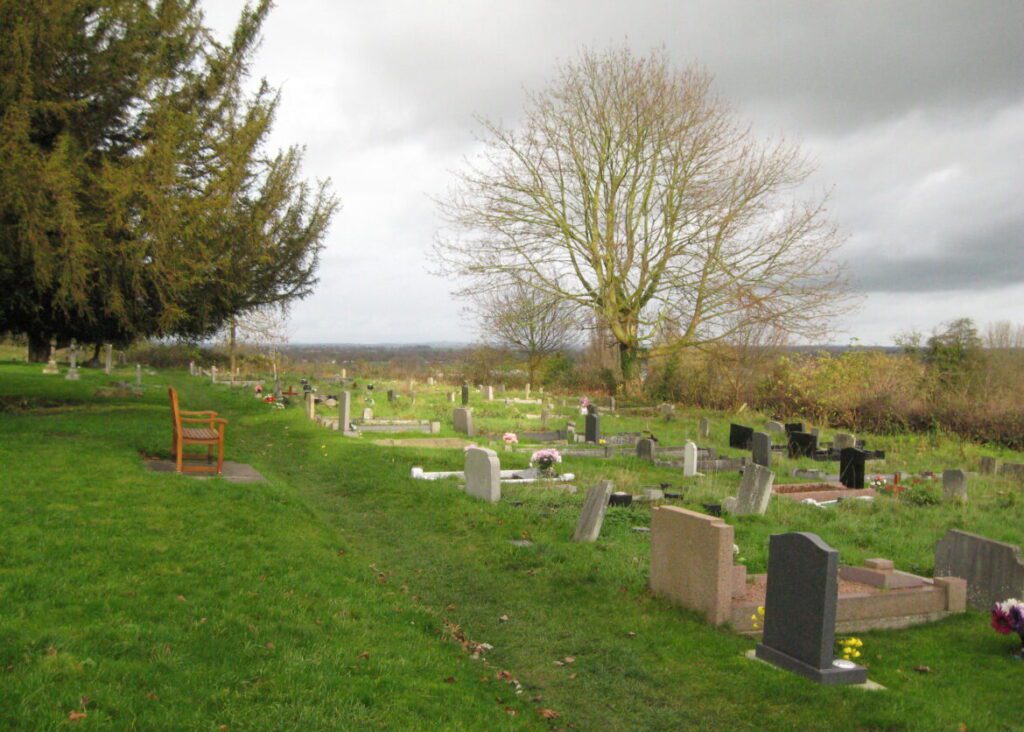Between Counties, Between Worlds
TUTBURY, England — It felt entirely appropriate that the Tutbury and Hatton train stop sits between the two villages, and between two counties: Derbyshire and Staffordshire. The platform itself is little more than a pause in the line, a threshold between places.
As a returning traveler to Britain’s Pagan landscape after nearly fifteen years abroad, I could not have imagined a more fitting place to arrive — in neither one county nor the other, but somewhere in between, suspended in that familiar liminal space where old and new worlds meet.

Churchyard view 1 – Tutbury, Staffordshire by Martin Richard Phelan – Geograph Britain and Ireland- CCA-SA 2.0]
Sacred Landscapes and Energy Fields
Conference organizers Alistair Hindmarsh and Steve Mitchell opened the day with “More Thoughts and Experiments on Sacred Landscape,” exploring how electromagnetic fields may influence our attraction to particular places — especially the Dove Valley around us. They theorize that layers of sedimentary rock beneath the area generate electromagnetic patterns that drew early peoples to its mounds, which became ancient Pagan sacred sites.
In early Christianity, it was common to build churches atop Pagan places of worship. Hindmarsh and Mitchell revealed how many churches dedicated to Saint Mary now stand upon these raised mounds. Over time, the Celtic goddess Brigid was Christianized as Saint Brighid and later merged into the figure of Mary, a transformation that supports their claim that these churches rest upon ancient Pagan foundations. Their work invites us to consider how the earth itself might communicate with us, not metaphorically but through measurable, energetic currents. The notion that sacredness may emerge from geology as much as mythology challenges us to listen differently to the land.

Sacred Landscapes Conference Logo
![]()
We know it’s a pain to ask for money—but here are the facts.
Since January, The Wild Hunt’s readership has soared past 400,000 views a month. That’s humbling—but higher reach also means higher costs. Hosting, technology, and reporting all add up.
Our editors are unpaid, and some of our staff volunteer their time. But we believe everyone deserves to be paid for their work.
We tried advertising once, and readers were flooded with Christian ads. That’s not who we are. The Wild Hunt is dedicated to providing Pagan readers perspectives they won’t see anywhere else.
We’ll never hide our stories behind a paywall—our community deserves access, no matter their ability to pay. To keep Pagan news free, independent, and authentic, we rely on you.
A few hundred supporters pledging $10 a month — or more if you can — would keep The Wild Hunt secure for the year. If you’ve been thinking about supporting us, now is the time.
👉 This is how you can help:
Tax-Deductible Donation
PayPal
Patreon
As always, our deepest gratitude to everyone who has brought us this far.
![]()
The Moon Beneath Our Feet
I was especially struck by their observation that the moon we look to for tides, cycles, and emotional shifts also exists, in part, beneath our feet. When the planet Theia collided with the early Earth, debris formed the moon, but some of that material became embedded deep within the planet’s crust. To think that the same celestial body guiding our rituals also slumbers below us felt almost devotional. It reframes every act of grounding as a lunar communion, not just an earthly one.
The Living Soil
Next came Sian Sibley with “The Living Soil,” a passionate and accessible presentation on the mycelial networks that sustain life and how Pagans might form a more reciprocal relationship with the soil and the spirits of place. Sibley urged practitioners to take responsibility for ecological harm sometimes caused by our own rituals , from leaving toxic clooties and paraffin tea lights to relying on crystals mined in destructive ways.
Her ideas resonated deeply with many in the room, a reminder that animism, if sincerely practiced, must extend beyond reverence into responsibility.
“If we believe stones are alive,” she asked, “why not gather them locally instead of plundering the earth?” Her challenge was both uncomfortable and inspiring, pushing us to reflect on how easily good intentions can drift into harm.
Symbols, History, and the Green Man
After lunch, the tone shifted from the ecological to the historical and symbolic. The afternoon explored how we might preserve the imagery, myths, and symbols that have carried meaning for centuries. Crichton Miller warned of the loss of ancient icons in an age of artificial intelligence, while Mark Olly traced the origins and evolution of the Green Man.
Their scholarship grounded the day’s mysticism without diminishing it; rather, it affirmed how much mystery still surrounds us. There are more things in heaven and earth, and humanity remains young upon this planet, still learning the language of spirit and stone alike.
Celebrating Sacred Places
The day concluded with Gordon the Toad’s talk, “Celebrating Sacred Landscapes,” an invitation to develop our own criteria for what makes a place sacred. His warmth and humor brought together the day’s themes: the deep time of geology, the living network of soil, and the enduring symbols through which we glimpse the divine in the land.
As the event closed, Mitchell shared a glimpse of what lies ahead. “Al and I are turning up new research all the time,” he said. “We hope to host more day conferences, hands-on experiments, and seasonal events that unite celebration with the sacred.”
Returning to the Threshold
As I left the station once more, standing again between two counties and two worlds, I was reminded that sacredness often lies not in arrival but in the journey between — in those thresholds where the ancient and the modern quietly meet.
![]()
![]()

